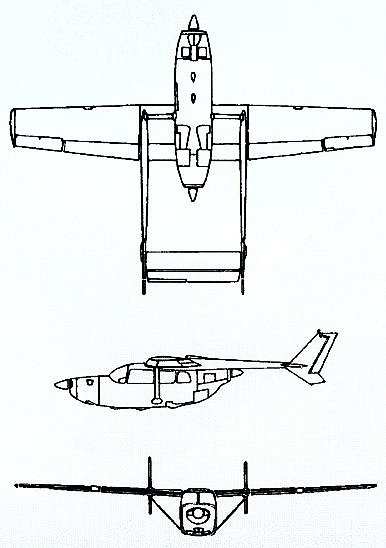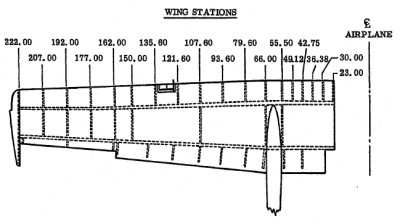Thu, May 13, 2010
Recommendations Follow Fatal Accident In 2009
 The FAA has published a revised Special Airworthiness
Information Bulletin (SAIB) for Cessna Models 336, 337, and F337
(Reims) series airplanes with wingtip extensions. The
Administration says the revision is a result of comments received
from individuals and other airworthiness authorities. It
The FAA has published a revised Special Airworthiness
Information Bulletin (SAIB) for Cessna Models 336, 337, and F337
(Reims) series airplanes with wingtip extensions. The
Administration says the revision is a result of comments received
from individuals and other airworthiness authorities. It
corrects a typographical error, adds to the list of models
potentially affected, and adds to the list of focused
inspections.
The SAIB is based on preliminary investigation findings from a
fatal accident involving a Cessna Model T337G. The airplane
experienced separation of a six-foot section of the outboard right
wing. This airplane had been modified with an STC for extended
wingtips. It also had an additional STC for winglets. For more
information on the accident, see the NTSB preliminary report
ERA10FA140. The subsequent investigation revealed there have also
been reports from the field of wrinkled skins, working rivets,
cracks, and loose wing tips. The FAA notes that Cessna Service
Newsletter SNL06-6, FAA Approved Supplemental Type Certificates
(STC’s) and FAA-PMA Approved Parts, as well as Aviation
Enterprises Wing Extension Service Letter AE01-11-00 have already
been issued for the modification.

The FAA recommends that owners and operators of the listed
aircraft:
- Review and adhere to all published airspeed and maneuvering
limitations for the modified airplane. Look for excessive
“bowing” of the tip extensions in flight.
- Perform a one-time general inspection of the wings for internal
and external damage from Wing Station (WSTA) 23 to the wing tip
within the next 100 hours time-in-service (TIS). Remove all wing
access panels to conduct the inspection. Areas to focus on are
listed below. Do this inspection following the appropriate
manufacture’s service information and any other appropriate
guidance, such as FAA Advisory Circular AC 43.13-1B Acceptable
Methods, Techniques, and Practices - Aircraft Inspection and
Repair.
Focused inspection items to focus on:
- Wrinkles in upper wing skins.
- Cracking of the upper wing skins. Pay particular attention to
any wrinkles, the radius between stiffeners at Wing Station (WSTA)
150 (under fuel tank covers), and unreinforced access holes.
- Smoking rivets at the rib near the inboard aileron hinge (WSTA
162).
- Missing fastener hardware, particularly for attachment of the
tips.
- Excessive looseness of attachments of the tip extension to the
wing and wing tip to wing extension when pushing up and down on the
tip.
- Any signs of distress along both front and rear spars,
particularly in the area around WSTA 177.
- Unusual repairs to the upper skins, particularly in the area of
WSTA 150-162, and Inter-rivet buckling of the stringers attached to
the upper surface skin, outboard of the fueltank access
covers.

In the case of multiple STC installations on the same aircraft,
the FAA says to make sure the following determination, noted on the
STC certificate, has been made: "This approval should not be
extended to aircraft of this model on which other previously
approved modifications are incorporated unless it is determined
that the interrelationship between this change and any of those
other previously approved modifications will introduce no adverse
effect upon the airworthiness of that aircraft."
The FAA says the investigation into this incident is ongoing,
but has not determined that the condition warrants an Airworthiness
Directive at this time.
More News
Aviation Governance Secured...At Least For a While The National Business Aviation Association similarly applauded the passage of the FAA's recent reauthorization, contentedly recou>[...]
Emphasis On Growing The Future of Aviation Through Concentration on 'AFFORDABLE FLYERS' It's been a number of years since the Latest Edition of Jim Campbell's HUGE SportPlane Resou>[...]
Amazilia Aerospace GmbH, Develops Digital Flight Control, Flight Guidance And Vehicle Management Systems Textron eAviation has acquired substantially all the assets of Amazilia Aer>[...]
Honeywell's Primus Brings New Tools and Niceties for Hawker Operators Hawker 4000 business jet operators have a new installation on the table, now that the FAA has granted an STC f>[...]
Company Celebrates Niche-but-Important Advancement in Industry Standards Echodyne has announced full integration of its proprietary 'EchoFlight' radar into the e American Aerospace>[...]
 Bolen Gives Congress a Rare Thumbs-Up
Bolen Gives Congress a Rare Thumbs-Up The SportPlane Resource Guide RETURNS!!!!
The SportPlane Resource Guide RETURNS!!!! Buying Sprees Continue: Textron eAviation Takes On Amazilia Aerospace
Buying Sprees Continue: Textron eAviation Takes On Amazilia Aerospace Hawker 4000 Bizjets Gain Nav System, Data Link STC
Hawker 4000 Bizjets Gain Nav System, Data Link STC Echodyne Gets BVLOS Waiver for AiRanger Aircraft
Echodyne Gets BVLOS Waiver for AiRanger Aircraft





